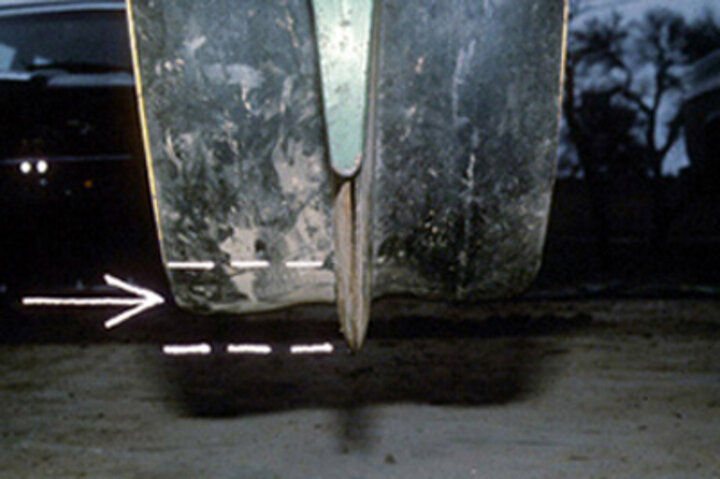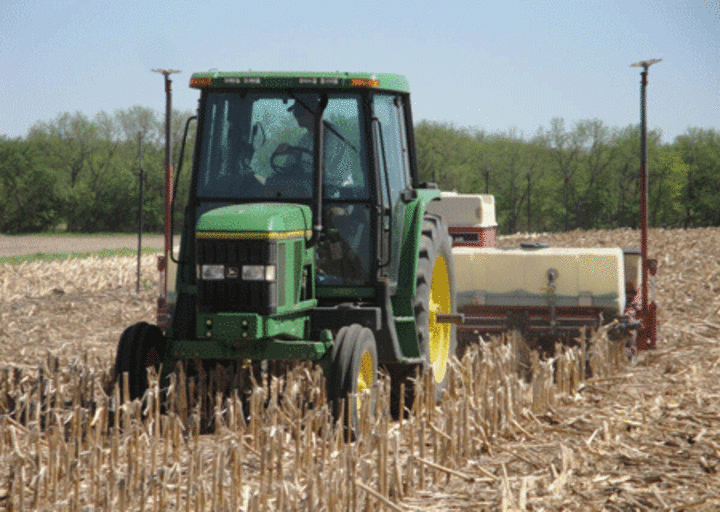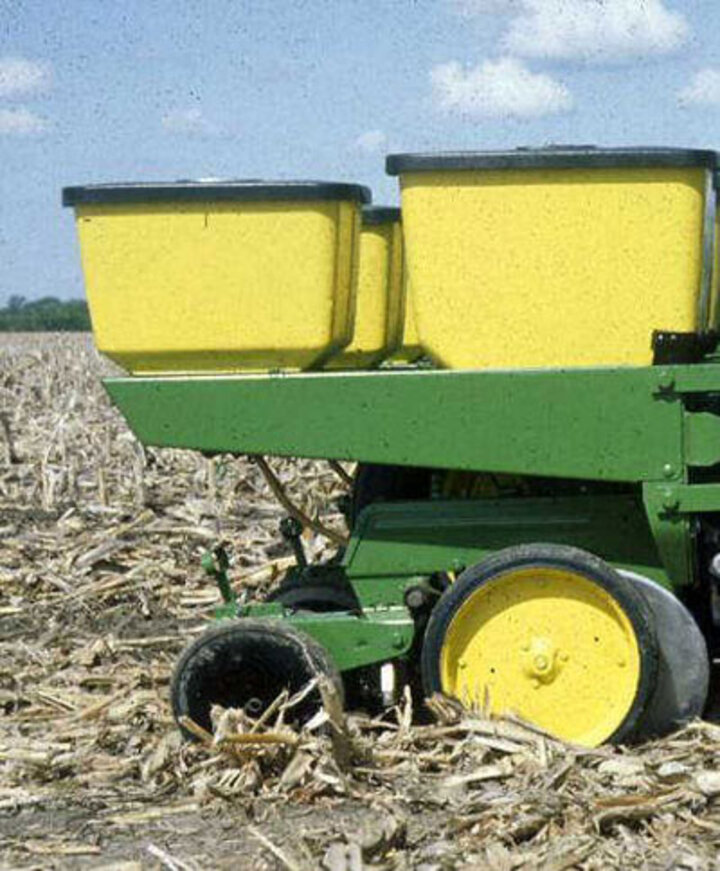In no-till, planters need to
- cut and handle residue,
- penetrate the soil to the desired seeding depth,
- establish proper seed-to-soil contact, and
- close the seed-vee.


Keeping these four items in mind, producers can evaluate the strengths or weaknesses of their planter and make any adjustments or changes necessary to make no-till successful. Fortunately, most planters can be used for no-till with few, if any, modifications when paying attention to the following tips.
Maintain sharp openers. Double-disk openers, if sharp and properly maintained, can cut through residue without coulters or residue movers. Adjust the disk openers so they work together as a single cutting edge with about 2 inches of blade contact on the standard disks or about 1½ inches on the heavy-duty, thicker disks (Figure 1). (Staggered disks should be adjusted to just touch.) When replacing the disk openers, also replace the seed tube protector as it holds the disks apart to reduce blade flexing and acts as a scraper to help keep the disks clean. If hair pinning residue is a problem, increase the planting depth some to improve the residue cutting angle of the disks.
Don't seed between the old rows. By planting down the old rows, the seeds will be placed in the most biologically active area of the field (Figure 2). The decaying roots from last year leave channels in the soil for the new roots to grow in. Avoid planting in the heart of the wheel track from last year as that is the most compacted area in the field. Planting about 4 inches to the side of the old row works well for corn on corn where uniform depth control is critical. This also reduces tire wear compared to driving on the root stumps to plant between the old rows.
Watch planting speed. Keep the speed around 5 miles per hour to reduce planter unit bounce and deliver the seeds uniformly. Be wary of ads that say a planter can "meter seed" at 7 to 8 mph. That doesn't mean it can deliver the seeds to the soil uniformly at higher speeds, especially on rough fields. Often the resulting non-uniformity from operating at higher speeds reduces yields enough to justify a larger planter (or a second planter) to complete planting in a timely manner.
Increase the down pressure. The residue of no-till, especially in hard, dry soil, requires down pressure springs and extra weight (as necessary) on the planter to cut through and penetrate the soil to achieve desired seeding depth. Enough down pressure should be on the row units to make sure that the depth gauging wheels are actually gauging planting depth. Check the down pressure on the row units as conditions change to avoid over-compacting wet soils, creating sidewall compaction.
Place seeds at a uniform depth. Make sure all the seeds are placed at the bottom of the seed-vee into good soil moisture for uniform emergence. Keeton Seed Firmers or Schaffert Rebounders are recommended for a more uniform planting depth for more uniform emergence. These units also provide convenient in-furrow fertilizer application options. The Keeton Seed Firmers also improve seed-to-soil contact as the name implies.
Keep residue uniform. Consider residue movers on the planter to "even up" and create a uniform residue layer, especially if the residue was not uniformly spread during harvest or some residue was drifted by the wind. However, if the residue cover is already uniform, such as in long-term no-till, residue movers can do more harm than good. In these cases, the movers break residue loose from the soil and some of the residue can then blow back over the row, creating non-uniform conditions. In addition, some of the emerging corn may leaf out under the residue and have difficulty surviving.
Close the seed-vee. The seed-vee should be properly closed for good seed-to-soil contact and to reduce drying out of the seed zone. Spoked closing wheels are often added to planters to help close the seed-vee. They serve three purposes:- drying the soil with tillage,
- closing the seed-vee while fracturing the sidewall, and
- providing loose soil above the seed.
The loose soil created by the spoked wheels reduces the chances of the seed-vee opening back up as the soil dries, especially on wet clay soils. However, depending on the moisture situation, the tillage of the closing wheels might dry out the soil too much. In some cases, growers get better results using one spoked wheel and one regular closing wheel. Also, some closing wheel brands have less aggressive spokes than others and some provide some soil firming to reduce drying.

Level the planter. The planter should be level to slightly tail down in back, with the toolbar at the proper height so that the parallel links run parallel to the soil surface (FIgure 3). If the planter runs nose down, the openers will tend to bulldoze and may plug with residue. When operated tail down, the cutting edge on the double disk openers is in a better position to cut residue on the soil surface. Also, as the planter runs nose down, the tail assembly of the closing wheels doesn't run level. As the pivot point of the closing wheel arm gets lower (either by leveling the planter tail down or by planting deeper), the angled closing wheels have more of a pinching action and they will do a better job of closing the seed-vee.
Consider planting deeper. Planting the seeds deeper puts them into a more buffered soil environment with a more uniform soil temperature and soil moisture. This improves uniformity of emergence which increases yields. Also, by planting deeper, the root system is better established, improving standability and allowing the plant to better handle stresses. Corn should be planted at least 2 inches deep as most corn planters were designed for planting depths of 2 to 3 inches. Consider the 3-inch planting depth in dry years and low residue conditions to reduce the chances of the seed zone drying out.
Paul Jasa
Extension Engineer
